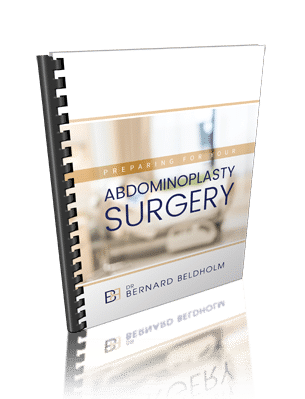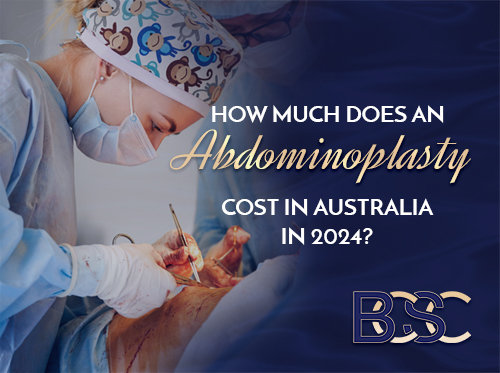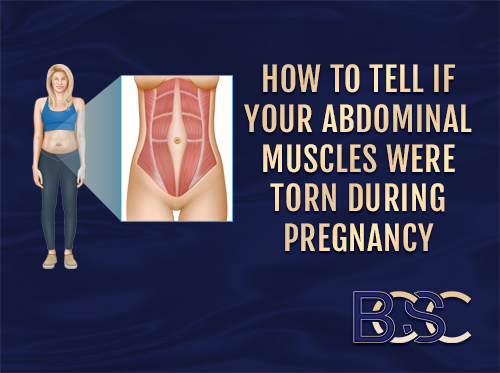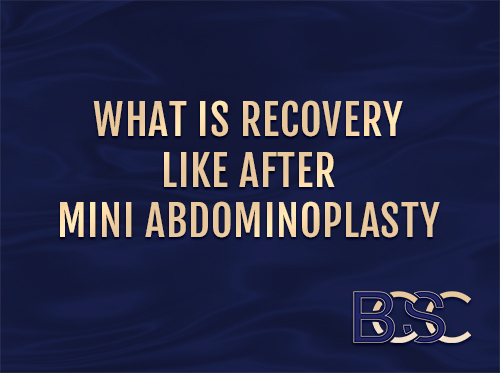Everything You Need to Know About Abdominoplasty Complications
The layman’s idea of plastic surgery, many times referred to as cosmetic surgery, is a procedure to alter your appearance. While plastic surgery can change the shapes and contours of your body, that is only part of the process. Every cosmetic benefit from plastic surgery is a byproduct of a medical solution.
Like any surgery involving general anaesthesia, plastic surgery is far more complicated than most people realise. As more Australians turn to body contouring surgery to help with their health issues, there’s a need for awareness about the potential complications of plastic surgery — especially more popular procedures like abdominoplasties.
What is an Abdominoplasty?
An abdominoplasty is abdominal contour surgery that is commonly referred to as a “tummy tuck.” Don’t let the friendly-sounding name fool you; the so-called tummy tuck is a serious surgery that has been known to cause complications. An abdominoplasty is a surgery where excess skin and fat in the abdomen are removed, and connective tissues and muscles are tightened.
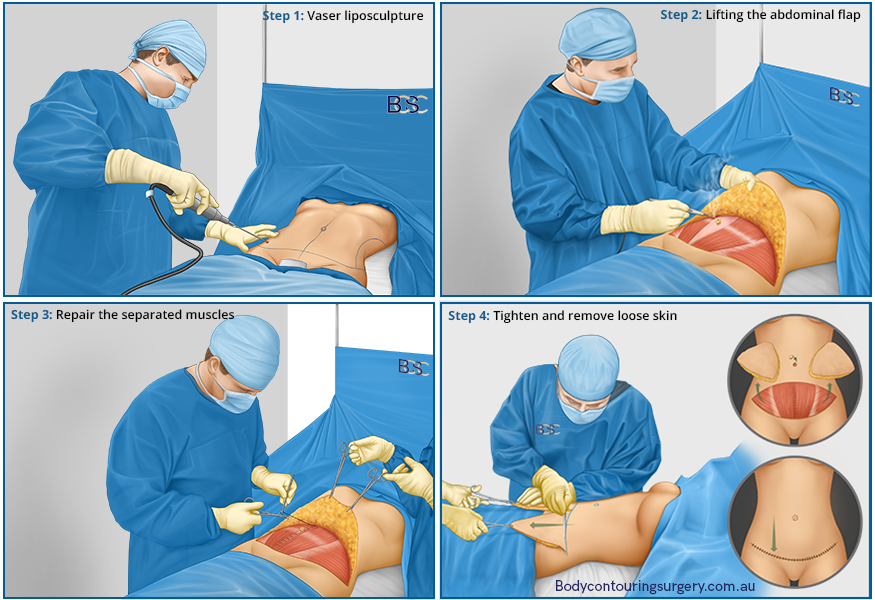
Steps in an abdominoplasty surgery
Patients undergoing abdominoplasty need to be aware of the common complication rates as well as the potential complications, including the severe complications from this surgery.
A 2022 report by Finder discovered that as many as 1.2 million Australians had undergone some form of plastic surgery in the last 12 months. Many of those were tummy tucks — abdominoplasties were the fourth most common procedure in Australia.
Can Abdominoplasty Surgery Lead to Health Complications?
An experienced specialist surgeon can perform a successful abdominoplasty. But that doesn’t mean it is a straightforward operation by any means. In fact, among cosmetic procedures, abdominoplasties have been found to have a higher risk of major complications than average. This is supported by findings from a study published in the medical journal, Plastic and Reconstructive Surgery®.
The study examined nearly 25,000 abdominoplasties over five years. Four percent of abdominoplasty patients suffered major complications, significantly higher than the average rate of 1.4% for other cosmetic procedures (ref 1). We will look at some of the significant complications that could be a concern for abdominoplasty patients below.
It’s also worth mentioning the minor complications of abdominoplasties. Discomfort after the surgery, scarring, and adverse reactions to anesthesia are some examples.
Major Health Complications Caused by Abdominoplasty Surgery

List of complications after abdominoplasty surgery
Deep Vein Thrombosis

Abbreviated as DVT, Deep Vein Thrombosis is a serious, if rare, complication that arises after an abdominoplasty. DVT occurs when a blood clot forms in a deep vein, often in the legs. A 2017 study that included 129,007 aesthetic procedures found that elective operations like abdominoplasties carry as much as a 2% chance of thrombosis (blood clot formation in the vein) (ref 2).
Dangers of a DVT
DVT can cause short-term symptoms that lead to extreme discomfort. Some symptoms of DVT are:
- Swollen legs
- Cramps and pains in the legs
- Changes in skin colour on the leg
- Warm sensation in one leg
Apart from these troubling symptoms, DVT can also lead to more deadly complications. When a blood clot breaks loose and travels through the veins, it can lead to a Pulmonary Embolism (PE)- which is potentially life-threatening. It occurs when the blood clot travels to the lungs and gets lodged in the blood vessels. Signs of PE include:
- Chest pains that grow worse while breathing or coughing
- Fainting and dizzy spells
- Shortness of breath
- Rapid pulse
- Coughing blood
If you experience DVT or PE symptoms after an abdominoplasty, get medical attention immediately.
Treatment of a DVT
If you are suffering from DVT, your doctor will likely prescribe drugs to cure you. Blood thinners are commonly used to prevent existing blood clots from getting bigger and new clots from forming. In more extreme cases of severe blood clotting, thrombolytics may be administered through an IV to break down the clot. Surgical options include placing a mesh filter in a large vein (the vena cava) to keep clots out of the lungs.
Seroma
An abdominoplasty involves removing a considerable amount of tissue (abdominal flap). This leads to one of the most common complications seen after abdominoplasties (and, indeed, any major surgery), seromas (fluid accumulation). A seroma is a medical term for a build-up of fluid (serum) under the skin’s surface. This fluid accumulation can sometimes take weeks to appear after surgery.
A 2021 research paper titled “The Global Prevalence of Seroma After Abdominoplasty analysed 143 studies conducted across five continents. It found that the global prevalence of seromas after an abdominoplasty was 10.9% (ref 3).
Dangers
Not all seromas are harmful. Minor fluid accumulation can sometimes disappear as the body naturally reabsorbs the fluid. However, larger seromas do cause complications. A seroma can sometimes leak. As long as the discharge is clear, there is little cause for worry. But if the discharge becomes whitish or extremely bloody, it can mean the seroma has become infected. An infected seroma develops into an abscess, which puts you at risk of sepsis.
If your seroma is infected, you may notice the following symptoms:
- Fever
- Blood pressure changes
- Rapid heart rate
Treatment
Seromas require medical attention. Seromas are generally aspirated to remove the fluid. Larger seromas may require surgery, where the fluid is drained out of the body via tubes.
Necrosis (Skin and Fat)
When the skin and fatty tissue don’t receive adequate blood supply through the circulatory system, necrosis can occur. Procedures like abdominoplasties, where a lot of body tissue is restructured, can often cause trauma, leading to reduced blood supply and, eventually, tissue death.
In an article titled “Minimising complications in abdominoplasty: An approach based on the root cause analysis and focused preventive steps,” the author observes that when necrosis is observed after an abdominoplasty, it’s usually an occurrence of both skin and fat necrosis (ref 4). The signs of necrosis are visible two-to-four days after the abdominoplasty operation.
Dangers
Skin necrosis is essentially dead skin that requires surgical treatment. Small amounts of necrosis can be removed, and the skin restitched with minimal cosmetic complications. On the other hand, larger amounts of necrosis may need extensive surgery or even skin grafts- which could leave scars. This complication often leads to multiple procedures being required.
Treatment
If left untreated, necrosis will result in the skin falling out like a scab. This will also result in a scar. If left to heal on its own, it is called ‘heeling by secondary intention’ and could take months to heal entirely.
Necrosis is a surgical problem that requires a specialist surgeon (FRACS) to treat the abdominal region.
Minor necrosis (about two centimetres of affected area) will involve cutting away dead tissue and restitching skin. This is referred to as primary closure.
The skin cannot be closed primarily if there is a more significant amount of necrosis. In such a case, the dead skin must be ‘debrided.’ The scar resulting from a debridement is first managed with a VAC (negative pressure) dressing for a few weeks.
Once the tissue has healed, the surgeon will decide how best to close the area, depending on the scar. This could be through skin grafting or primary closure.
Haematoma

Sometimes, postoperative abdominoplasty patients’ blood vessels can rupture or burst. The resulting pool of blood that collects under the skin’s surface is known as a haematoma.
Abdominal haematomas are commonly seen after abdominoplasty operations. A study at the University of Parma, Italy, analysed 25 abdominoplasty procedures and found occurrences of haematomas in three cases. Haematomas affected 12% of the abdominoplasty patients included in the study (ref 5).
Dangers
In appearance, haematomas look similar to a bruise. Abdominal haematomas will appear as a patch of discoloured skin. Symptoms associated with abdominal haematomas include pain, swelling, and tenderness in the affected area. If not treated, if will usually lead to increasing persistent pain.
Treatment
The treatment approach for haematomas depends on their severity. In mild cases, they can be treated like any other soft tissue injury. The R.I.C.E. (Rest, Ice, Compression, Elevation) Method is a good home remedy for mild haematomas.
Larger haematomas usually require surgical intervention, which entails an open incision and the insertion of a drain to wash out the blood.
In some cases, the haematoma can expand- indicating active bleeding in the area. This is an emergency, and the patient must be taken to the operating theatre to find the bleeding vessel and remove the haematoma.
Other Complications from an abdominoplasty
We’ve reviewed some of the major complications associated with abdominoplasty surgery. Along with them, other minor complications may arise as well. While they may not pose a serious risk to your long-term health, they can negatively impact your satisfaction levels with your abdominoplasty operation.
Some of these conditions may even necessitate another visit to the surgeon’s table for a corrective procedure.
- Postoperative pain, numbness, and weakness
- Undesirable scarring, hyper-pigmented and keloid scars
- Hypertrophic scars
- Skin discolouration
- Loose skin flaps (colloquially referred to as “dog ears”)
- Asymmetrical or lopsided scars
- Slow wound healing
- Anaesthesia-related complications
- Wound infection
- Changes in skin sensation
Risk Factors for abdominplasty complications

It’s true that abdominoplasty surgery is linked with various major and minor health complications. But not every patient that goes in for an abdominoplasty is exposed to the same level of risk. Multiple studies have been conducted on abdominoplasty complications, and they have identified specific groups of patients that are at higher risk than others (ref 6). Those groups include:
- Elderly patients over 60 years old
- Those who undergo an abdominoplasty as part of a combined procedure
- Obese patients
- Patients with a history of previous health complications
- Men are more likely than women to develop complications after an abdominoplasty
- Smoking is one of the biggest risk factors for surgery
When considering an abdominoplasty procedure, have an exhaustive discussion about possible complications with your surgeon. Abdominoplasties are elective procedures, so make sure you’re voting the right way for your body and overall well-being. Always remember, an abdominoplasty is NOT a shortcut to lose weight! A healthy lifestyle is the only way to do that.
Frequently Asked Questions
What are the most common complications of a tummy tuck (abdominoplasty)?
The most common complications seen after a tummy tuck are seromas, delayed or poor wound healing throughout, haematomas, and post-operative bleeding. Less frequently, some patients may suffer from skin or fat necrosis. Even more rarely, some patients may develop Deep Vein Thrombosis (DVT), which is a major complication that requires serious medical attention.
How many people have complications from a tummy tuck (abdominoplasty)?
Abdominoplasty is one of the most popular plastic surgery procedures. But it also has a higher rate of complications than other cosmetic surgeries. Approximately 4% of abdominoplasty patients experience some form of medical complications after their surgeries. Individuals at a higher risk of experiencing complications usually relate to patients with overall poorer general health, including:
- Obese individuals – defined as a Body Mass Index (BMI) of more than 30
- Elderly individuals
- Individuals with a family history of associated complications
- Smokers
This is why it is important for your surgeon to know your past medical history.
What are the long-term problems after a tummy tuck (abdominoplasty)?
An abdominoplasty surgery can sometimes result in long-term complications. These can lead to aesthetic dissatisfaction and physical discomfort. Some long-term issues that can arise after an abdominoplasty include:
- Scarring problems: Poor scar placement can lead to dissatisfaction. Also, some patients may develop hypertrophic or keloid scars, or their scar may heal in an asymmetric pattern.
- Numbness: The skin of the abdomen may develop a persistent feeling of numbness that does not recede even after healing.
- Nerve issues: Chronic pain problems are reported in some abdominoplasty patients after surgery.
These problems lead to unsatisfied patients and the need for revision surgery.
What are the red flags after a tummy tuck (abdominoplasty)?
For the first six weeks after undergoing an abdominoplasty, you should expect a level of discomfort as your body heals. The skin around the abdominal muscles in your abdomen will feel tighter and more stretched, your incision site will appear red and raised, and you will have a temporary fluid-filled swelling in the area of the incisions. If these symptoms persist for longer than six weeks or two months, you should contact your surgeon to discuss the results and find a treatment.
Sources
- Wolters Kluwer Health: Lippincott Williams and Wilkins. 2015. ”’Tummy tuck’ complications: Study looks at rates and risk factors.” Plastic and Reconstructive Surgery, 2015
- Julian Winocour, Varun Gupta, Christodoulos Kaoutzanis, Hanyuan Shi, R Bruce Shack, James C Grotting, K Kye Higdon. 2017. “Venous Thromboembolism in the Cosmetic Patient: Analysis of 129,007 Patients” Aesthetic Surgery Journal, Volume 37, Issue 3
- Nader Salari, Behnaz Fatahi, Yalda Bartina, Mohsen Kazeminia, Mohammadbagher Heydari, Masoud Mohammadi, Mahvan Hemmati, Shamarina Shohaimi. 2021. “The Global Prevalence of Seroma After Abdominoplasty: A Systematic Review and Meta-Analysis” Aesthetic Plastic Surgery, 2021 Dec
- Mohan Rangaswami. 2013. “Minimising complications in abdominoplasty: An approach based on the root cause analysis and focused preventive steps” Indian Journal of Plastic Surgery, v.46(2); May-Aug 2013
- Michele Grieco, Eugenio Grignaffini, Francesco Simonacci, Edoardo Raposio. 2015. “Analysis of Complications in Postbariatric Abdominoplasty: Our Experience” Plastic Surgery International, v.2015
- Arash Momeni, Mathias Heier, Holger Bannasch, G. Björn Stark. 2008. “Complications in abdominoplasty: A risk factor analysis” Journal of Plastic, Reconstructive, and Aesthetic Surgery, 2009 Oct
Resources for Research (For your reference)
- Finder.com. May 2, 2022. “Plastic Surgery Statistic Australia” [Accessed June 23, 2023] https://www.finder.com.au/plastic-surgery-statistics-australia
- TheVictorianCosmeticInstitute.com.au. January 16, 2020. “Cosmetic Surgery Statistics Australia & Around the World” [Accessed June 23, 2023] https://www.thevictoriancosmeticinstitute.com.au/2020/01/cosmetic-surgery-statistics-australia-around-the-world/
